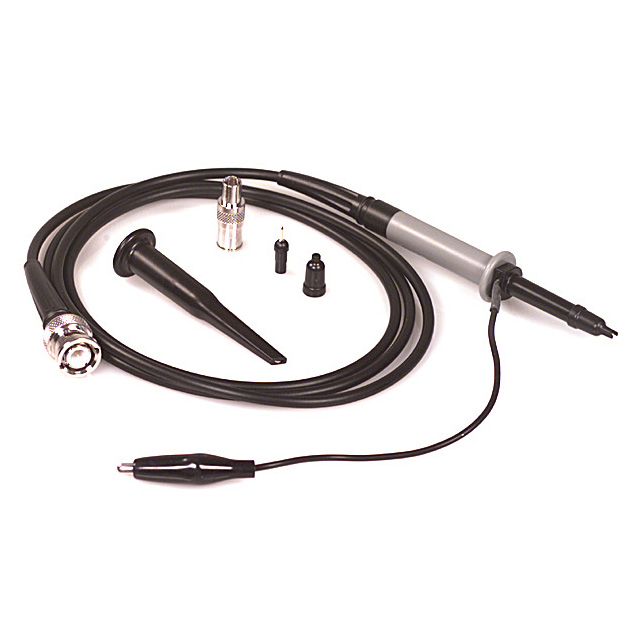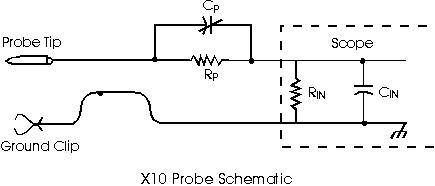| |
Importance of X10 Oscilloscope Probes |
|
A scope probe is built to minimize ringing by adding resistance. A X1 is better than a piece of co-ax, but a X10 probe is more effective than a X1. A X10 probe has the effect of reducing capacitance by a factor of ten. The trade-off is that is also attenuates the signal by a factor of ten. That is, 1/10 the signal applied to the tip of the probe actually reaches the input of the oscilloscope.

Here is something you may have experienced: You build a simple digital circuit using flip-flops, like a ripple-counter, and it seems to be working OK. But as soon as you try to look at one of the Q outputs with your scope, things get funny. You don't see what you expect to see; maybe the counter even stops working. What's going on?
The answer may be your scope probe. Instead of using an actual scope probe, you may have a length of coaxial cable ("co-ax") with a BNC connector at one end and a couple of alligator clips at the other. It may work fine for looking at lower frequency sine-waves, but it's the wrong thing for digital circuits.
Here's the problem: that piece of coax has a certain amount of capacitance (50 pF/foot is typical) and a certain amount of inductance. But it has very little resistance. So what you have is a resonant circuit with very little damping. Trying to put a fast rise-time digital signal through it is like hitting a bell with a hammer. That cable is going to "ring".
When a cable rings, a signal applied at the input end will travel up the cable, echo off the other end, and travel back down to the input where it arrives, out of phase, on top of the signal you're trying to measure. The result is that at the point you attach the cable, you cause transients: very narrow voltage "spikes" that go both positive and negative.
Scope Probe
Getting back to your digital circuit, by causing a voltage spike in the middle of your counter you cause the flip-flops to change state. Obviously a spike on an input can "flip" your flip-flop. But so can a spike on an output. The solution is to use a real scope probe instead of a piece of co-ax. Usually you want a properly adjusted "X10" probe. Probes can be X1 ("times-one") or X10 ("times-ten"). Often a probe has a switch on it so you can use it in either X1 mode or in X10 mode.
A scope probe is built to minimize ringing by adding resistance. A X1 is better than a piece of co-ax, but a X10 probe is more effective than a X1. A X10 probe has the effect of reducing capacitance by a factor of ten. The trade-off is that is also attenuates the signal by a factor of ten. That is, 1/10 the signal applied to the tip of the probe actually reaches the input of the oscilloscope. ASCII Version of This Schematic for Text Only Browsers
Schematic
Above is the schematic of the circuit inside a X10 probe. You can see that it is basically a voltage divider. Rp and Cp are selected to form a 10 to 1 divider with the input of the scope. Assume that the scope has 1 Meg-Ohm input resistance and 100 pF of input capacitance. Then Rp is 9 Meg-Ohms and Cp is 9 pF (remember: small C gives big X). Note that Cp is adjustable. That's to allow for adjusting the response of the cable to fast rise times. Often Cp can be adjusted with a small screwdriver. It may be located at the probe end of the cable, or at the end that attaches to the scope.
Most scopes have a "calibrator output" somewhere on the front panel. It supplies a square-wave to look at with your probe. Adjust Cp until the rising edge of the square-wave looks like Figure 2 below. ASCII Version of These Figures for Text Only Browsers
Fig. 1, 2, 3 - Under- Properly- and Over-Compensated
Now you should be able to look at signals in your digital circuits without flipping your flops. Also, if you are using a frequency counter to measure the frequency of a digital signal, then ringing in the coax will give you a false reading. Again, the solution is a X10 probe. And that's today's technical tip.


Related Links
Downloads
Importance of X10 Oscilloscope Probes - Link
|
|
|
| |
Accurate LC Meter
Build your own Accurate LC Meter (Capacitance Inductance Meter) and start making your own coils and inductors. This LC Meter allows to measure incredibly small inductances making it perfect tool for making all types of RF coils and inductors. LC Meter can measure inductances starting from 10nH - 1000nH, 1uH - 1000uH, 1mH - 100mH and capacitances from 0.1pF up to 900nF. The circuit includes an auto ranging as well as reset switch and produces very accurate and stable readings. |
|
PIC Volt Ampere Meter
Volt Ampere Meter measures voltage of 0-70V or 0-500V with 100mV resolution and current consumption 0-10A or more with 10mA resolution. The meter is a perfect addition to any power supply, battery chargers and other electronic projects where voltage and current must be monitored. The meter uses PIC16F876A microcontroller with 16x2 backlighted LCD. |
|
|
|
60MHz Frequency Meter / Counter
Frequency Meter / Counter measures frequency from 10Hz to 60MHz with 10Hz resolution. It is a very useful bench test equipment for testing and finding out the frequency of various devices with unknown frequency such as oscillators, radio receivers, transmitters, function generators, crystals, etc. |
|
1Hz - 2MHz XR2206 Function Generator
1Hz - 2MHz XR2206 Function Generator produces high quality sine, square and triangle waveforms of high-stability and accuracy. The output waveforms can be both amplitude and frequency modulated. Output of 1Hz - 2MHz XR2206 Function Generator can be connected directly to 60MHz Counter for setting precise frequency output. |
|
|
|
BA1404 HI-FI Stereo FM Transmitter
Be "On Air" with your own radio station! BA1404 HI-FI Stereo FM Transmitter broadcasts high quality stereo signal in 88MHz - 108MHz FM band. It can be connected to any type of stereo audio source such as iPod, Computer, Laptop, CD Player, Walkman, Television, Satellite Receiver, Tape Deck or other stereo system to transmit stereo sound with excellent clarity throughout your home, office, yard or camp ground. |
|
USB IO Board
USB IO Board is a tiny spectacular little development board / parallel port replacement featuring PIC18F2455/PIC18F2550 microcontroller. USB IO Board is compatible with Windows / Mac OSX / Linux computers. When attached to Windows IO board will show up as RS232 COM port. You can control 16 individual microcontroller I/O pins by sending simple serial commands. USB IO Board is self-powered by USB port and can provide up to 500mA for electronic projects. USB IO Board is breadboard compatible. |
|
|
|
|
ESR Meter / Capacitance / Inductance / Transistor Tester Kit
ESR Meter kit is an amazing multimeter that measures ESR values, capacitance (100pF - 20,000uF), inductance, resistance (0.1 Ohm - 20 MOhm), tests many different types of transistors such as NPN, PNP, FETs, MOSFETs, Thyristors, SCRs, Triacs and many types of diodes. It also analyzes transistor's characteristics such as voltage and gain. It is an irreplaceable tool for troubleshooting and repairing electronic equipment by determining performance and health of electrolytic capacitors. Unlike other ESR Meters that only measure ESR value this one measures capacitor's ESR value as well as its capacitance all at the same time. |
|
Audiophile Headphone Amplifier Kit
Audiophile headphone amplifier kit includes high quality audio grade components such as Burr Brown OPA2134 opamp, ALPS volume control potentiometer, Ti TLE2426 rail splitter, Ultra-Low ESR 220uF/25V Panasonic FM filtering capacitors, High quality WIMA input and decoupling capacitors and Vishay Dale resistors. 8-DIP machined IC socket allows to swap OPA2134 with many other dual opamp chips such as OPA2132, OPA2227, OPA2228, dual OPA132, OPA627, etc. Headphone amplifier is small enough to fit in Altoids tin box, and thanks to low power consumption may be supplied from a single 9V battery. |
|
|
|
|
|
Arduino Prototype Kit
Arduino Prototype is a spectacular development board fully compatible with Arduino Pro. It's breadboard compatible so it can be plugged into a breadboard for quick prototyping, and it has VCC & GND power pins available on both sides of PCB. It's small, power efficient, yet customizable through onboard 2 x 7 perfboard that can be used for connecting various sensors and connectors. Arduino Prototype uses all standard through-hole components for easy construction, two of which are hidden underneath IC socket. Board features 28-PIN DIP IC socket, user replaceable ATmega328 microcontroller flashed with Arduino bootloader, 16MHz crystal resonator and a reset switch. It has 14 digital input/output pins (0-13) of which 6 can be used as PWM outputs and 6 analog inputs (A0-A5). Arduino sketches are uploaded through any USB-Serial adapter connected to 6-PIN ICSP female header. Board is supplied by 2-5V voltage and may be powered by a battery such as Lithium Ion cell, two AA cells, external power supply or USB power adapter. |
|
200m 4-Channel 433MHz Wireless RF Remote Control
Having the ability to control various appliances inside or outside of your house wirelessly is a huge convenience, and can make your life much easier and fun. RF remote control provides long range of up to 200m / 650ft and can find many uses for controlling different devices, and it works even through the walls. You can control lights, fans, AC system, computer, printer, amplifier, robots, garage door, security systems, motor-driven curtains, motorized window blinds, door locks, sprinklers, motorized projection screens and anything else you can think of. |
|
|
|